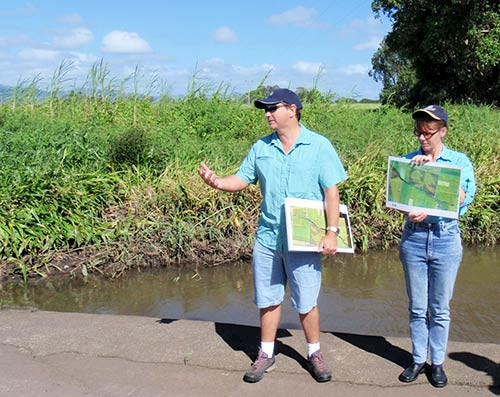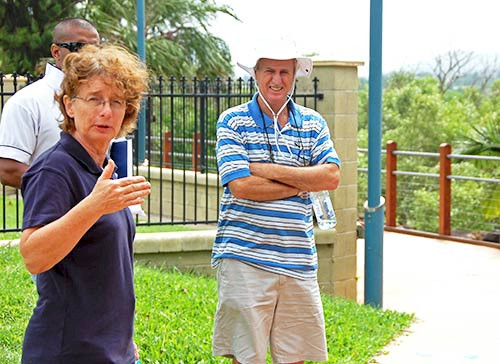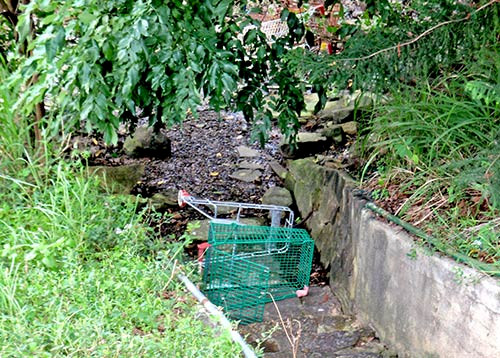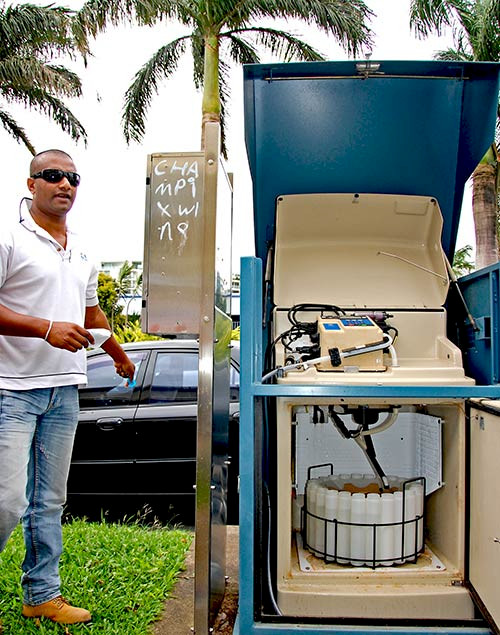Mackay field trip #1: Lagoons, champions and mangroves
Bill Dennison ·Uncovering a lost lagoon
The Sandringham lagoon case study was described by Tim Marsden from the Queensland Department of Employment, Economic Development and Innovation (DEEDI). Standing in front of the lagoon, Tim showed before and after photos and described the process of clearing the weeds that completely choked the lagoon. The lagoon had become completely covered with a one meter thick mat of roots and decomposing plant material due to elevated nutrient levels from cane farm runoff and the introduction of various exotic plants originally from South America.

Hymenachne amplexicaulis is a grass from South America that was introduced into Australia in 1988 for cattle food in large areas of artificial wetlands for pastures. These 'ponded pastures' are beneficial for cattle but the spread of Hymenachne into sugarcane waterways and pastures can become problematic. The other exotic South American plants in Sandringham lagoon are water hyacinth (Eichhornia crassipeas), a free floating flowering plant that grows rapidly. It was introduced to Australia as an ornamental plant in the early 1900s. Salvinia molesta is a small aquatic fern that floats on the water surface, growing completely hydroponically.
The floating plants as well as the ones coming in from the stream banks served to completely cover the lagoon water surface. No light could penetrate the mat of roots and decomposing organic material in bottom waters reduced dissolved oxygen levels. Tim indicated that they could only catch a couple species of small fish before the lagoons were restored.
The restoration plan involved getting the private landowners along the length of the lagoon to join with the Department of Environment and Natural Resources (DERM) and DEEDI. One of the farmers figured out how to make a large rake mechanism, seven meters wide, that could reach out across the lagoon and drag the weeds into the shore. They developed a method of cutting the mat away from the far shore and using the rake to drag the mat to the shore. There was so much vegetation that three large trucks ferried loads of vegetation to a hole in an adjacent paddock dawn to dusk for five weeks. Herbicides were applied to the rotting vegetation to ensure that they wouldn't re-sprout.
This activity was conducted five years ago and now there are a diversity of fish including the iconic barramundi that use the lagoon as a nursery area, akin to the 'green zones' used as no fishing zones for fisheries habitat in the estuaries and marine waters. The lagoon still requires maintenance to keep the weeds from reinvesting and this is accomplished with landowners mowing and spraying from the shoreline and the fisheries team spraying from a boat. The original project was several hundred thousand dollars, but funding for maintenance is minimal.
From the site, we could also see some of the infrastructure for the Kinchant dam water irrigation network and a groundwater test well (bore) used to monitor the groundwater levels, alongside 4 m high sugarcane. The bridge had fish ladders underneath to facilitate movement of fish from the estuary into the lagoon. There were some large Melaluca trees along the lagoon shoreline, but not a well-developed riparian buffer. At least the cane was not growing right down to the water's edge.
Mangrove dieback & shopping carts
We visited a mangrove dieback site, where the mangroves appeared fairly healthy following a large dieback a decade ago. Dr. Judith Wake from Central Queensland University told us that the cause of the 2000-2002 mangrove dieback has been a matter of dispute, with alternative theories of pesticide poisoning vs. desiccation from nutrient stimulated leaf growth and drought leading to hypersalinity. The mangroves near the sewage treatment effluent remained healthy, possibly due to constant freshwater and nutrient inputs. She has been investigating nutrient ratios of leaves and Pulse Amplitude Fluorometric responses to various treatments.

We could see several shopping carts pushed down into the mangroves along the Pioneer River. I recalled my colleague Prof. Stuart Bunn joking that as they did the scoping trips around the Southeast Queensland rivers and streams that the number of shopping carts was a good indicator of stream health. Since shopping carts discarded into waterways are an indicator of proximity to large impervious surfaces (parking lots and shopping center roofs), and an indication of how much people care about their waterways, the joke may be a reality.

Adjacent to the mangrove site was an urban stormwater autosampler next to the sidewalk. Rowan Jararathne from Mackay Regional Council described the sampling strategy and indicated that early results had low nutrients and low hydrocarbons. It was on a quiet, dead end street without much traffic or commercial activity, so perhaps those results are not surprising. Judith mentioned that the surficial sediments had low concentrations of lead, but that deeper down in the sediments, high lead concentrations could be found.

Creating environmental champions
We stopped at Homebush public school and the Reef Guardian program was explained by Carolyn Thompson from the Great Barrier Reef Marine Park Authority. Carolyn was one the few GBRMPA staff not based in Townsville, as she worked out of Mackay. The Reef Guardian program has been instituted at 238 schools throughout Queensland. They started the program in Townsville, but now schools throughout Queensland, including inland schools and even schools in Brisbane. Pre-schools, primary and secondary schools have Reef Guardian programs. The program provides teaching materials along a sustainability theme. Students conduct water quality sampling and learn about the connectivity of catchment activities with reef health. Carolyn emphasized the ownership that the students developed and when they started at a new school without the Reef Guardian program, they would advocate for the school to adopt the program. From these examples, it appears that the Reef Guardian program is effectively creating champions for the environment.
This is the first of two posts about Bill's participation in a field trip to Mackay, Queensland, Australia.
The second post is:
2. Mackay field trip #2: Sugarcane
About the author
Bill Dennison

Dr. Bill Dennison is a Professor of Marine Science and Vice President for Science Application at the University of Maryland Center for Environmental Science.

